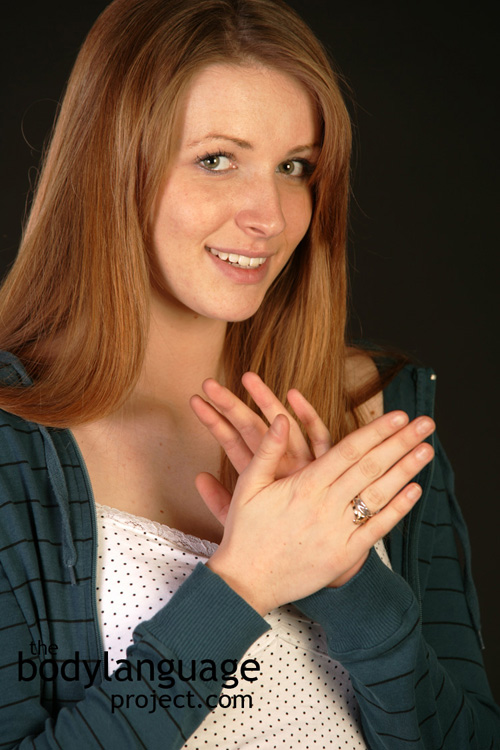Body Language of Clapping
Synonym(s): Applause
Description: The hands come together quickly and slap each other to make an audible sound.
In One Sentence: When the hands come together to make a clapping sound it shows others that we are excited or approving.
How To Use it: Use clapping to show others your approval. You may also use a slow clap to show the reverse. The slow clap is “sarcastic.”
Context: General.
Verbal Translation: “I’m happy and excited so I slap my hands together and make lots of noise.”
Variant: Feet can also be slapped if the other hand is busy, drinks clinked, fingers snapped and hands waved (a silent applause). A slow clap shows that one is sarcastic about approval thus showing the reverse message.
Cue In Action: The audience clapped their hands to show their appreciation for the wonderful song played by the orchestra.
Meaning and/or Motivation: A celebratory nonverbal signal usually done by large audiences untoward a presenter or performer. Clapping can also be done to show general happiness such as when hearing the telling a funny joke.
Cue Cluster: Clapping is accompanied by true smiles, open facial expressions, relaxed body postures and joyful screaming.
Body Language Category: Energy Displacement, Enthusiasm (nonverbal), Expansive movements, Gravity defying body language, Happiness, Liking, Relaxed body language.
Resources:
Bull, Peter. Invited and uninvited applause in political speeches. British Journal of Social Psychology, 2006, Vol.45(3), pp.563-578.
Bull, Peter. Six key indicators guaranteed to reduce audience stress and increase your applause. Records Management Quarterly. 1997. 31(3): 18(4).
Bull, Peter. Booing: The Anatomy of a Disaffiliative Response. American Sociological Review. 1993. 58(1): 110-130.
Bavelas, J. B., Black, A., Chovil, N., Lemery, C. R., & Mullett, J. (1988). Form and function in motor mimicry: Topographic evidence that the primary function is communicative. Human Communication Research, 14, 275- 299.
Bavelas, J. B., Black, A., Lemery, C. R., & Mullett, J. (1986). “I show how you feel”: Motor mimicry as a communicative act. Journal of Personality and Social Psychology, 50, 322-329.
Chartrand, T. L.,& Bargh, J. A. (1999). The chameleon effect: The perception behavior link and social interaction. Journal of Personality and Social Psychology, 76, 893-910.
Fitzpatrick, Paula ; Schmidt, R. C. ; Lockman, Jeffrey J. Dynamical Patterns in the Development of Clapping. Child Development. 1996. 67(6): 2691-2708.
Fletcher, Alison W. Clapping in chimpanzees: evidence of exclusive hand preference in a spontaneous, bimanual gesture. American Journal of Primatology. 2006. 68(11): 1081-1088.
LaFrance, M. (1979). Nonverbal synchrony and rapport: Analysis by the cross-lag panel technique. Social Psychology Quarterly, 42, 66-70.
Mann, Richard P ; Faria, Jolyon ; Sumpter, David J T ; Krause, Jens. The dynamics of audience applause. Journal of the Royal Society, Interface / the Royal Society. 2013. 10(85): 2013046.
Manusov, Valerie. Mimicry or synchrony: The effects of intentionality attributions for nonverbal mirroring behavior. Communication Quarterly. 1992 40(1): 69-83.

